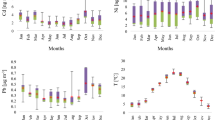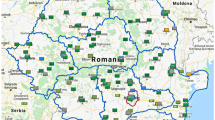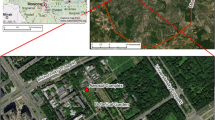Abstract
The aim of this study was to identify levels of population health risk caused by the inhalation of PM10-bound species in an urban area. A combination of multiple location measurements, several analytical tools, and cancer and non-cancer health risk assessment was used to evaluate influences of proximate anthropogenic activities and air pollution transport. The concentrations of PM10, six trace metals (As, Cd, Cr, Mn, Ni and Pb) and benzo[a]pyrene were measured at 15 air quality monitoring stations during the period 2011–2015 in a wide area of Belgrade (Serbia). Significant population health risk was estimated as a result of exposure to particulate air pollution. The concentrations of PM10, As, Ni and benzo[a]pyrene exceeded the EU Directive limit and target values. Of all the analysed species, Cr was the major contributor to carcinogenic health risk. Besides strong local sources related to traffic and industry, the influence of transported pollution is estimated in the range 8.95–36.07 %, with potentially the most important sources being located in East and West Europe.




Similar content being viewed by others
Notes
Determination of the PM10 fraction of suspended particulate matter—reference method and field test procedure to demonstrate reference equivalence of measurement methods.
Standard method for the measurement of Pb, Cd, As and Ni in the PM10 fraction of suspended particulate matter.
References
An X, Hou Q, Li N, Zhai S (2013) Assessment of human exposure level to PM10 in China. Atmos Environ 70:376–386
Anderson J, Thundiyil JG, Stolbach A (2012) Clearing the air: a review of the effects of particulate matter air pollution on human health. J Med Toxicol 8:166–175. doi:10.1007/s13181-011-0203-1
ANPI (2015) Australian Government Department of the Environment National Pollutant Inventory. Cadmium and compounds. http://www.npi.gov.au/resource/cadmium-and-compounds. Accessed 3 January 2016
AQE (2015) Air qualiti in Europe - 2015 report. European environment agency, publications office of the European Union, Luxembourg
AQP (2015) Air quality plan in agglomerations Belgrade. http://www.beograd.rs/download.php/documents/PlankvalitetavazduhaEkologija.pdf (in Serbian). Accessed 3 January 2016
ATSDR (2012) Agency for Toxic Substances and Disease Registry. Toxicological Profile for Manganese. http://www.atsdr.cdc.gov/toxprofiles/tp151-c6.pdf Accessed in 3rd January 2016
Bernard A (2008) Cadmium & its adverse effects on human health. Indian J Med Res 128:557–564
CalEPA (1996) Risk Assessment Advisory Committee. A review of the California Environmental Protection Agency’s risk assessment practices, policies, and guidelines. Office of Environmental Health Hazard Assessment, California Environmental Protection Agency. http://oehha.ca.gov/risk/raac/AppA_GnoB.pdf. Accessed 3 January 2016
CalEPA (2003) Air Toxic Hot Spots Program guidance manual for preparation of health risk assessment. Office of Environmental Health Hazard Assessment (OEHHA), California Environmental Protection Agency. http://oehha.ca.gov/
CalEPA (2008) Air Toxics Hot Spots risk assessment guidelines, technical support document for the derivation of noncancer reference exposure levels. Office of Environmental Health Hazard Assessment (OEHHA), California Environmental Protection Agency. http://oehha.ca.gov/Assessed. Accessed 3 January 2016
Carslaw DC, Ropkins K (2012) Openair—an R package for air quality data analysis. Environ Model Softw 27:52–61. doi:10.1016/j.envsoft.2011.09.008
Diaz RV, Dominguez ER (2009) Health risk by inhalation of PM2.5 in the metropolitan zone of the City of Mexico. Ecotox Environ Safe 72:866–871
Draxler RR, Rolph GD (2014) HYSPLIT (HYbrid single-particle Lagrangian integrated trajectory) model. Access via NOAA ARL READY website (http://ready.arl.noaa.gov/HYSPLIT.php). NOAA Air Resources Laboratory, Silver Spring
EA (2008) A review of toxicity of arsenic in air. Science Report - SC020104/SR4, Bristol, UK
EEA (2015) Report no 5/2015. Air quality in Europe—2015 report. European Environment Agency, Copenhagen
EQR (2014) http://www.beograd.rs/download.php/documents/Plan.pdf (in Serbian). Accessed 3 January 2016
EU (2004) Directive of the European Parliament and of the Council relating to arsenic, cadmium, mercury, nickel and polycyclic aromatic hydrocarbons in ambient air. Directive 2004/107/EC
Flagan R, Seinfeld J (2012) Fundamentals of air pollution engineering. Dover Publication, Mineola
Fuzzi S, Baltensperger U, Carslaw K, Decesari S, Deniervan der Gon H, Facchini MC et al. (2015) Particulate matter, air quality and climate: lessons learned and future needs. Atmos Chem Phys 15:8217–8299
GDAS (2015) Global Data Assimilation System. https://www.ready.noaa.gov/gdas1.php. Accessed 3 January 2016
Henn BC, Schnaas L, Ettinger AS et al (2012) Associations of early childhood manganese and lead coexposure with neurodevelopment. Environ Health Perspect 120(1):126–131
Hijmans RJ, van Etten J, Cheng J, Mattiuzzi M, Sumner M, Greenberg JA et al. (2015) Package ‘raster’, R package
IARC (International Agency for Research on Cancer) (1990) Monograph on the evaluation of carcinogenic risks to humans, vol. 49. Lyons, France, pp 318–411
IPHB (Institute of Public Health of Belgrade). Available at www.zdravlje.org.rs (in Serbian). Accessed in 2015
Jamshed A, Tasneem GK, Jameel AB, Hassan IA, Mariam SA, Naeem U, Sadaf SA, Saima S (2015) Monitoring of arsenic fate with proximate parameters and elemental composition of coal from Thar coalfield, Pakistan. J Geochem Explor 159:227–233
Kim KH (2013) A review of airborne polycyclic aromatic hydrocarbons (PAHs) and their human health effects. Environ Int 60:71–80
Kneen MA, Annegarn HJ (1996) Algorithm for fitting XRF, SEM and PIXE X-ray spectra backgrounds. Nucl Instr Meth B 109:209–213
Langard S, Costa M (2014) Chromium. In: Nordberg G (ed) Handbook on the toxicology of metals, 4th edn. Elsevier, London
Laulicht F, Brocato J, Ke Q, Costa M (2014) Carcinogenicity of metals. In: Nordberg G (ed) Handbook on the toxicology of metals, 4th edn. Elsevier, London
Liaw A, Wiener M (2002) Classification and regression by random Forest. R News 2(3):18–22
Mancuso TF (1997) Chromium as an industrial carcinogen: part 1. Am J Ind Med 31:129–139
Mathew J, Goyal R, Taneja KK, Arora N (2015) Air pollution and respiratory health of school children in industrial, commercial and residential areas of Delhi. Air Qual Atmos Health 8:421–427
Menzie CA, Ziccardi LM, Lowney YW, Fairbrother A, Shock SS, Tsuji JS, Hamai D, Proctor D, Henry E, Su SH, Kierski MW, McArdle ME, Yost LJ (2009) Importance of considering the framework principles in risk assessment for metals 1. Environ Sci Tech 43(22): 8478–8482
Mijić Z, Stojic A, Perisic M, Rajsic S, Tasic M (2012) Receptor modeling studies for the characterization of PM10 pollution sources in Belgrade. Chem Ind Chem Eng Q 18(4):623–634
Morello‐Frosch RA, Woodruff TJ, Axelrad DA, Caldwell JC (2000) Air toxics and health risks in California: the public health implications of outdoor concentrations. Risk Anal 20(2):273–292
Murillo JH, Roman SR, Marin JFR, Ramos AC, Jimenez SB, Gonzalez SB, Baumgardner DG (2013) Chemical characterization and source apportionment of PM10 and PM2.5 in the metropolitan area of Costa Rica, Central America. Atmos Pollut Res 4:181–190
Murphy D, Hutchinson D (2015) Cadmium, road dust and rheumatoid arthritis: an alternative hypothesis to general air pollution. J Inflamm 12:58–70
Opentraj (2015) https://cran.r-project.org/web/packages/opentraj/opentraj.pdf. Accessed in 2015
Pandeya P, Patelb DK, Khana AH, Barmana SC, Murthyb RC, Kisku GC (2013) Temporal distribution of fine particulates (PM2.5, PM10), potentially toxic metals, PAHs and metal-bound carcinogenic risk in the population of Lucknow City, India. J Environ Sci Health A 48(7):730–745. doi:10.1080/10934529.2013.744613
Perišić M, Stojić A, Stojić SS, Šoštarić A, Mijić Z, Rajšić S (2015) Estimation of required PM10 emission source reduction on the basis of a 10-year period data. Air Qual Atmos Health 8(4):379–389
Pongpiachan S, Iijima A (2016) Assessment of selected metals in the ambient air PM10 in urban sites of Bangkok (Thailand). Environ Sci Poll Res 23(3):2948–2961
Pushan S, Vladimir S, Chris S, Peter FN (2007) Speciation of arsenic and selenium in coal combustion products. Energy Fuel 21:506–512
Querol X, Alastuey A, Pey J et al (2009) Variability in regional background aerosols within the Mediterranean. Atmos Chem Phys 9:4575–4591
Rajšić S, Mijić Z, Tasić M, Radenković M, Joksić J (2008) Evaluation of the levels and sources of trace elements in urban particulate matter. Environ Chem Lett 6:95–100
Rastogi AK (2013) http://code.google.com/p/metcor/. Accessed 3 January 2016
Rost J, Holst T, Sahn E, Klingner M, Anke K, Ahrens D, Mayer H (2009) Variability of PM10 concentrations dependent on meteorological conditions. Int J Environ Pollut 36(1):3–18
Mishra S, Bharagava RN (2016) Toxic and genotoxic effects of hexavalent chromium in environment and its bioremediation strategies. J Environ Sci Health C 34:1–32. doi:10.1080/10590501.2015.1096883
Schaumloffel D (2012) Nickel species: analysis and toxic effects. J Trace Elem Med Biol 26:1–6. doi:10.1016/j.jtemb.2012.01.002
Slezakova K, Castro D, Begonha A, Delerue-Matos C, da Conceição Alvim-Ferraz M, Morais S, do Carmo Pereira M (2011) Air pollution from traffic emissions in Oporto, Portugal: health and environmental implications. Microchem J 99(1):51–59
Sofowote U, Su Y, Dabek-Zlotorzynska E, Rastogi A, Brook J, Hopke F (2015) Sources and temporal variations of constrained PMF factors obtained from multiple-year receptor modeling of ambient PM2.5 data from five speciation sites in Ontario, Canada. Atmos Environ 108:140–150
Stanišić Stojić S, Stanišić N, Stojić A, Šoštarić A (2015) Single and combined effects of air pollutants on circulatory and respiratory system-related mortality in Belgrade, Serbia. J Toxicol Environ Health A 23:1–11. doi:10.1080/15287394.2015.1101407
Stojić A, Stojić SS, Mijić Z, Ilić L, Tomašević M, Todorović M, Perišić M (2015a) Comprehensive analysis of VOC emission sources in Belgrade urban area. In: Cohen A (ed) Urban and built environments: sustainable development, health implications and challenges. Nova Science, New York, ISBN: 978-1-63483-067-6
Stojić A, Stojić SS, Šoštarić A, Ilić L, Mijić Z, Rajšić S (2015b) Characterization of VOC sources in an urban area based on PTR-MS measurements and receptor modelling. Environ Sci Pollut Res 22(19):13137–13152
Stojić A, Stojić SS, Mijić Z, Šoštarić A, Rajšić S (2015c) Spatio-temporal distribution of VOC emissions in urban area based on receptor modeling. Atmos Environ 106:71–79
Stojić A, Stojić SS, Reljin I, Čabarkapa M, Šoštarić A, Perišić M, Mijić Z (2016) Comprehensive analysis of PM10 in Belgrade urban area on the basis of long-term measurements. Environ Sci Pollut Res 1–11. doi:10.1007/s11356-016-6266-4
Stull RB (1988) An introduction to boundary layer meteorology. Springer, London
Szabó J, Nagy AS, Erdős J (2015) Ambient concentrations of PM10, PM10-bound polycyclic aromatic hydrocarbons and heavy metals in an urban site of Győr, Hungary. Air Qual Atmos Health 8(2):229–241
Team RC (2012) R: a language and environment for statistical computing. http://cran.case.edu/web/packages/dplR/vignettes/timeseries-dplR.pdf. Accessed 3 January 2016
Todorović M, Perišić M, Kuzmanoski M, Stojić A, Šoštarić A, Mijić Z, Rajšić S (2015) Assessment of PM10 pollution level and required source emission reduction in Belgrade area. J Environ Sci Health A 50(13):1351–1359. doi:10.1080/10934529.2015.1059110
USEPA (2005) Chapter 8—Interpreting uncertainty for human health risk assessment. In: Human Health Risk Assessment Protocol. US EPA Region Multimedia Planning and Permitting Division, Office of Solid Waste Center for Combustion Science and Engineering. https://www.weblakes.com/products/iraph/resources/hhrap/chp_8.pdf. Accessed 3 January 2016
USEPA (2006) Air quality criteria for lead, final report. EPA/600/R-05/144aF-bF, 2006, U.S. Environmental Protection Agency, Washington, DC. http://cfpub.epa.gov/ncea/cfm/recordisplay.cfm?deid=158823#Download. Accessed 3 January 2016
USEPA (2011a) Methods to develop inhalation cancer risk estimates for chromium and nickel compounds. US EPA Office of Air Quality Planning and Standards, Research Triangle Park, NC 27711
USEPA (2011b) Exposure factors handbook. Office of Research and Development, Washington, DC
USEPA (2013) Integrated Risk Information System (IRIS). United States Environmental Protection Agency. http://www.epa.gov/iris. Accessed 3 January 2016
USEPA (2015) Residual risk assessment for the petroleum refining source sector. EPA’s Office of Air Quality Planning and Standards Office of Air and Radiation. https://www3.epa.gov/airtoxics/petrefine/604_RTR_Assessment091715withAppendices.pdf. Accessed 3 January 2016
Valavanidis A, Konstantinos F, Thomais V (2008) Airborne particulate matter and human health: toxicological assessment and importance of size and composition of particles for oxidative damage and carcinogenic mechanisms. J Environ Sci Health C 26:339–362
Vuković G, Aničić Urošević M, Goryainova Z, Pergal M, Škrivanj S, Samson R, Popović A (2015) Active moss biomonitoring for extensive screening of urban air pollution: magnetic and chemical analyses. Sci Total Environ 521:200–210
Wang YQ (2014) MeteoInfo: GIS software for meteorological data visualization and analysis. Meteorol Appl 21(2):360–368
Watson JG, Chen LWA, Chow JC, Doraiswamy P, Lowenthal DH (2008) Source apportionment: findings from the U.S. Supersites Program. J Air Waste Manag 58:265–288. doi:10.3155/1047-3289.58.2.265
WHO (2001) Arsenic and arsenic compounds. “Environmental health criteria, vol. 224”. World Health Organization, Geneva
WHO (2004) Concise International Chemical Assessment Document 63. Manganese and its compounds: environmental aspects. World Health Organization, Geneva
WHO (2006) Health risk of particulate matter from long-range transboundary air pollution. Regional Office for Europe, World Health Organization, Copenhagen
WHO (2013) Health risks of air pollution in Europe—HRAPIE project. Regional Office for Europe, World Health Organization, Copenhagen
Wickham H, Chang W (2015) Ggplot2: an implementation of the grammar of graphics, version 1.0. 1
Zhanghua C, Muhammad TS, Sandrah PE, Carrie VB, Frank DG (2015) Chronic effects of air pollution on respiratory health in Southern California children: findings from the Southern California Children’s Health Study. J Thorac Dis 7(1):1–11
Acknowledgments
This study was performed as part of projects no. III43007 and no. III41011, which were founded by the Ministry of Education, Science and Technological Development of the Republic of Serbia within the framework of integrated and interdisciplinary research for the period 2011–2016. The authors gratefully acknowledge Mr. Ankit Rastogi and the MetCor Project Team.
Author information
Authors and Affiliations
Corresponding author
Electronic supplementary material
Below is the link to the electronic supplementary material.
ESM 1
(DOCX 12559 kb)
Rights and permissions
About this article
Cite this article
Perišić, M., Rajšić, S., Šoštarić, A. et al. Levels of PM10-bound species in Belgrade, Serbia: spatio-temporal distributions and related human health risk estimation. Air Qual Atmos Health 10, 93–103 (2017). https://doi.org/10.1007/s11869-016-0411-6
Received:
Accepted:
Published:
Issue Date:
DOI: https://doi.org/10.1007/s11869-016-0411-6




